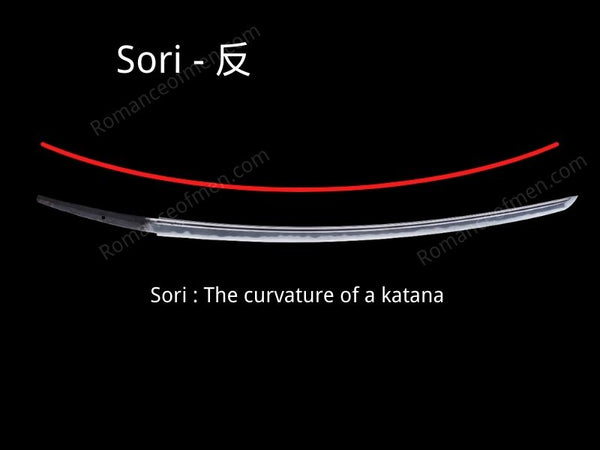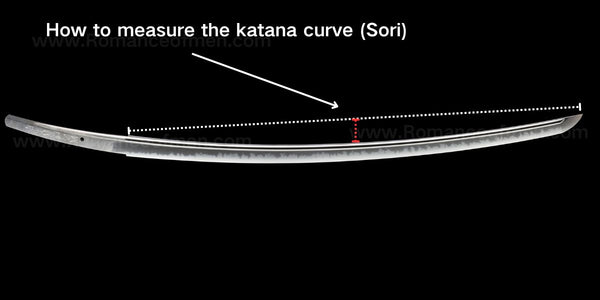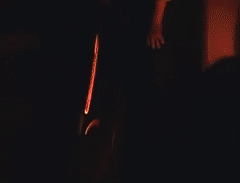Katana Sori The distinctive curve that makes samurai sword unique
Complete guide to understand Sori, the curve of Japanese Katana
The distinctive curve of Japanese swords really sets them apart from other swords around the world. This distinct curvature isn't merely for aesthetic appeal; it serves a practical purpose, enhancing the Katana's cutting power and agility. But how did this distinctive curve come to be, and what purpose does it serve? What are some different types of curvedness? This article will answer these questions, and you will understand deeper about the world of Japanese swords.

Table of Content
- What Is Sori in Katana?
- Benefits of the Katana Curve
- Six Types of Katana Curve (Sori)
- History and Development of Katana Curve
What Is Sori in Katana?
The Curvature of a Japanese sword is called Sori (反). In Japanese the word '反" literally means curve. Sometimes we see people use "Zori", it is because in Japanese there is a rule called "Rendaku", which changes the sound of words when they are put together. "Sori" is used when the word stands alone or starts a sentence. But when "sori" is in a compound word, the "s" changes to a "z," making it "zori." It's a common sound change in Japanese to make words flow better together.
How to measure the Katana curve correctly

To measure the curve (sori) of a Katana, imagine drawing a straight line from the tip of the sword (切先 kissaki) to the ridge on the back of the sword (棟区 munemachi). The curve is the longest distance between this line and the back of the blade.
How much curve should a katana have?
Usually the katana (Uchigatana) curve is about 1.5 cm (0.59 inches) deep, longer swords like Tachi can be as deep as 3 cm (1.18 inches) or more. There are no such thing as "Standard size" for sori, as we all know many katanas were custom made to fit the wielder's need. Generally speaking, a katana with deeper curve provides more advantages in horseback combat, allowing for quicker withdrawal of the blade after a strike. In the other end, the shallower curvature facilitates infantry battles. That's why Tachi is usually more curved than Uchigatana.
How does Katana gets the curve?
Unlike most people will imagine, the katana wasn't forged, hammered or cut into a curved shape. The curve was happened during a special quenching process called "Clay tempered". This involves heating the sword, then cooling it quickly, starting from the tip, which shapes the curve. Different thicknesses of clay are applied to different parts of the blade during this process, making the edge harder and the spine tougher. This method not only gives the katana its distinctive curve but also enhances its cutting ability and creates beautiful patterns (Hamon) on the blade.

Why Curved?
The reason behind the curvature of Katana is the "hiki-nuke" movement. It's like striking down your sword and immediately pulling it backward. Your arm needs to move in a circular trajectory. And your shoulder should be in the center.
This movement is pretty effective and quick. So, the curvature, or Sori, helps you move or strike with your katana more effectively than a straight sword.
Benefits of the Katana Curve
Better for Slashing movements
The Japanese katana is designed primarily for slashing. Its curved shape allows for effective cutting with minimal effort. Unlike straight, double-edged swords common in other regions, which are better for thrusting or striking, a katana's curve is not suitable for stabbing as the curve can cause the blade to slide off when attempting to pierce.
The curve of the katana plays a key role in its cutting motion. Instead of simply striking down like a straight sword, the katana's design facilitates a pulling motion during a cut. While it's possible to cut with a straight sword by pulling, it's not as efficient as with a katana. Effective cutting with a katana involves a circular motion centered around the shoulder.
The curvature of the katana, resembling a part of a circle or an arc, aids in this smooth pulling motion during a cut. This, combined with the katana's sharp edge, contributes to its high cutting efficiency and attack power with minimal force.
Optimized Weight Distribution
The Japanese katana, despite its actual weight (usually 1.5 kg / 3.3 lbs) , often feels lighter to the wielder. This is largely because the curve of the katana shifts its center of gravity towards the handle, or tsuka. This clever weight distribution makes the sword easier to handle and maneuver, especially in combat situations.
This balance of perceived lightness and actual weight makes the katana a remarkable weapon, suitable for a wide range of combat scenarios, and accessible even to those who might not possess great physical strength.
Easy to Draw
The curve aids in the quick and easy drawing of the katana, especially in critical combat situations. Japanese swords, ranging from the usual Uchigatana (打刀) to the larger Tachi (太刀), are typically long. Long swords are cumbersome to draw if it's straight, the curve makes it more convenient to draw and sheath, this is particularly true because katanas are traditionally carried at the waist.
Six Types of Katana Curve (Sori)
As mentioned, Sori is very important to katana in both practical and aesthetic way. There are Six types of sori, usually classified by the center point of the curve, we will explain them here:

Koshi-Zori (腰反り): Originating from the late Heian to early Kamakura periods, Koshi-Zori features a curvature near the Nakago (tang). The name "Koshi" translates to "waist," signifying a curvature resembling a waist-like bend. This type is one of the oldest in Japanese swords, indicative of ancient sword-making practices. It was commonly produced in the early sword-making regions of Japan.
Naka-Zori (中反り)/Tori-Zori (鳥居反り): Popular during the Kamakura period, Naka-Zori has the curvature's center around the middle of the blade. "Naka" means "middle," reflecting this central curvature. The alternative name, Tori-Zori, suggests a shape similar to a "Torii" gate, peaking in the middle. This style is often associated with swords from the Yamashiro region (山城伝), which was based in Kyoto, so this type of sori is also called "Kyozori" (京反り).
Saki-Zori (先反り): Saki-Zori, where the curvature is centered towards the tip of the blade, emerged during the Muromachi to Sengoku periods. "Saki" translates to "tip" or "end," pointing to the curvature towards the blade's tip. This style was likely developed to facilitate the ease of drawing the sword and was popular in regions where horse back battles were mainstream and often need to use swords with one hand.
Uchi-Zori (内反り): Unique for its curvature towards the edge rather than the back, Uchi-Zori is seen in swords from the Nara period and some from the Kamakura period. "Uchi" means "inside" or "inward," describing a curvature that bends inward towards the edge. This style is more common in older straight swords (Jokoto) and short swords (Tanto 短刀), particularly from the Kamakura era.
Takenoko-Zori (筍反り): A subtype of Uchi-Zori, Takenoko-Zori emerged in the Kamakura period, primarily in short swords crafted by the swordsmith Norishige. "Takenoko" means "bamboo shoot," reflecting the subtle, tapering curvature like that of a bamboo shoot. This style was prominent in the sword-making areas of the Kamakura period.
Mu-Zori (無反り): Found in swords from the Edo period, Mu-Zori is characterized by a lack of curvature. "Mu" means "none" or "without," describing this style's lack of curvature, straight like a bamboo training sword (Shinai). Mu-Zori swords were favored for their similarity to the Shinai, aligning with the training methods of the time.
History and Development of Katana Curve
The katana's curvature has evolved significantly over the centuries, influenced by changes in warfare tactics and cultural preferences. From the straight swords of the Nara period to the deeply curved blades of the Heian and Kamakura periods, and eventually to the more subtle curves of the Edo period and beyond, each era's swords reflect the needs and artistry of their time. Here we will give you a more detailed timeline:
Nara Period:
Swords in this period are mainly Chokuto (Straight swords), they were classified as Jokoto. They have no curve because the design was heavily influenced by Chinese swords.
Heian Period:
This period is crucial as it marks the beginning of the development of the modern katana. The major swords from this period are Tachi, they featured a significant curvature near the hilt, known as koshi-sori. The blades were longer and designed for both slashing and thrusting, making them more effective for mounted samurai.
Kamakura Period:
Over time, the Japanese sword design evolved, and the curvature shifted to Naka-Zori, which is a curvature more centered along the blade. And curve was usually 3 cm (1.1 inches) long.
This middle curvature became ideal for one-on-one combat, and more capable of cutting through thick Japanese armor in this period.
Muromachi Period:
Katanas of this period became shorter, blade length is around 60 cm (23 inches), and featured wider blades. There was a notable shift towards more pronounced saki-sori – curvature near the tip of the blade. And curve at this time was usually 1.8 cm (0.7 inches) long.
This indicated a continued adaptation to the needs of closer, more personal forms of combat, Uchigatana gradually replace Tachi and became the mainstream swords.
Conclusion
Curvature might be the most iconic feature of Japanese katana. In this article we know What sori is, how to measurement Sori, the average sori length, how curved was form, benefits of the curve and all types of katana sori, as well as the history and development of katana sori.
Hopefully, the discussion on Sori covered all the topics you wanted. Learning about all the types of Sori will help you choose your favorite katana. For more katana related information, you can check this blog.





















